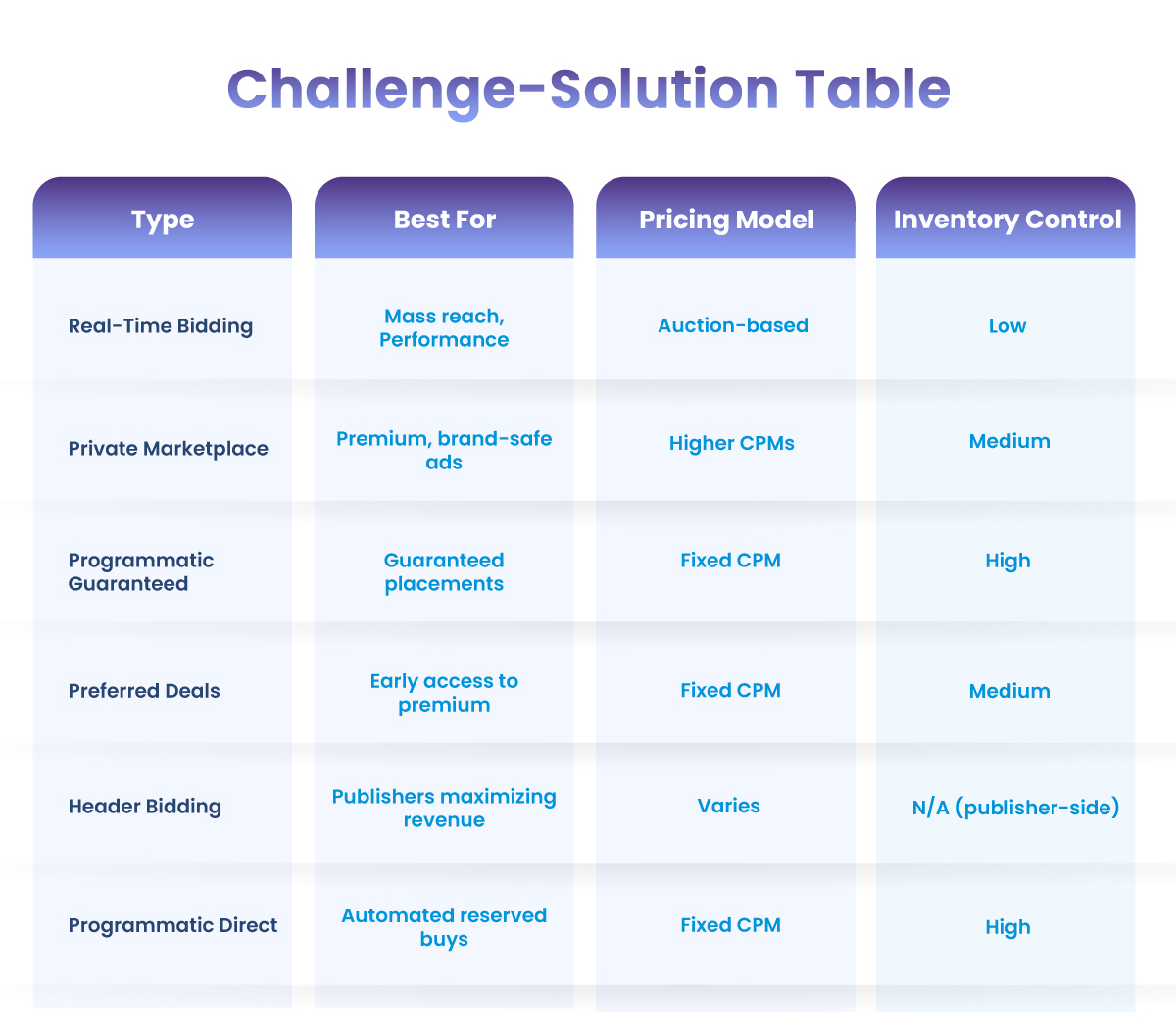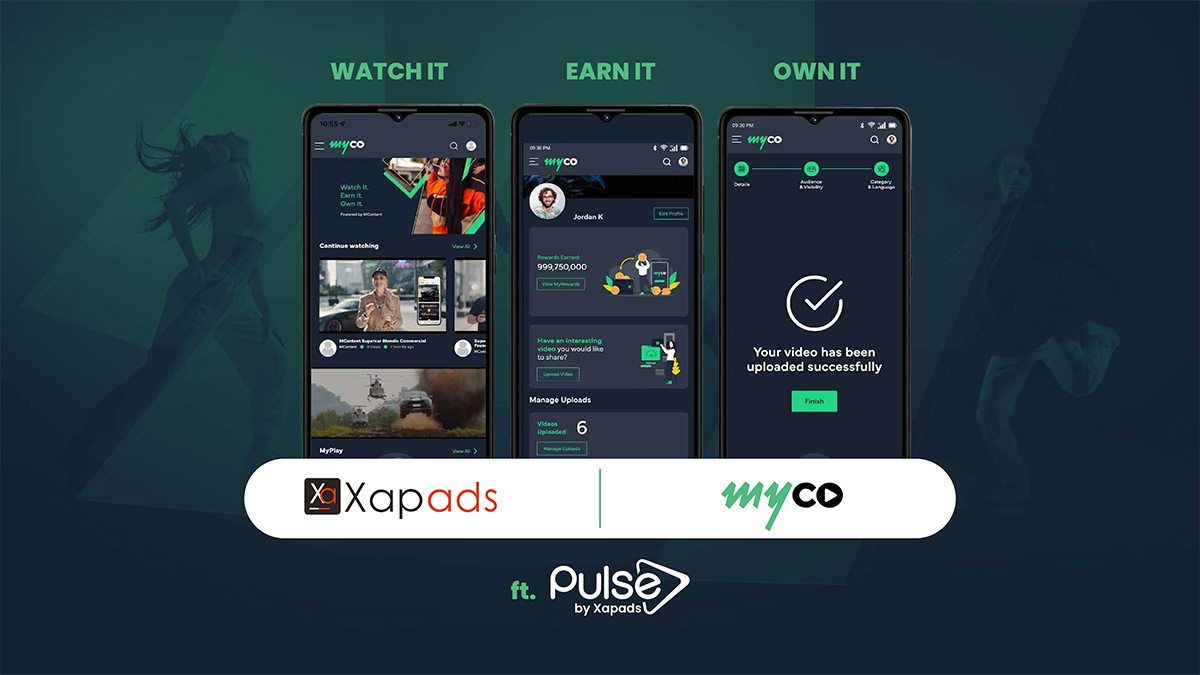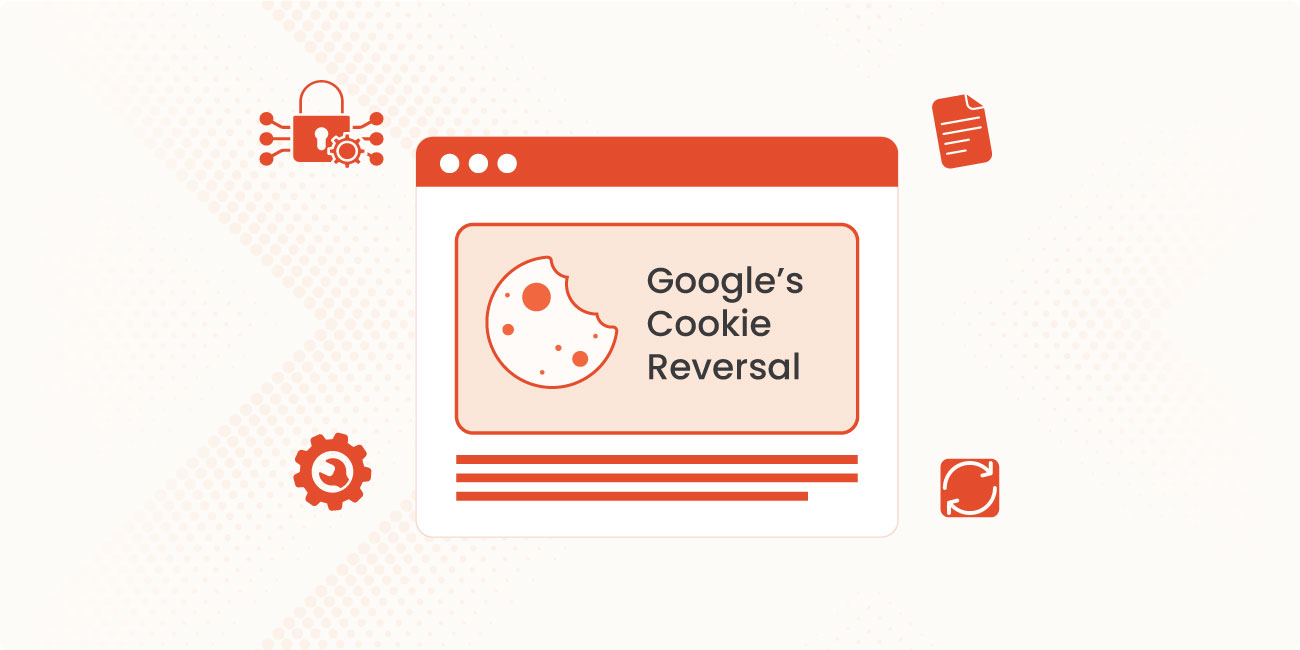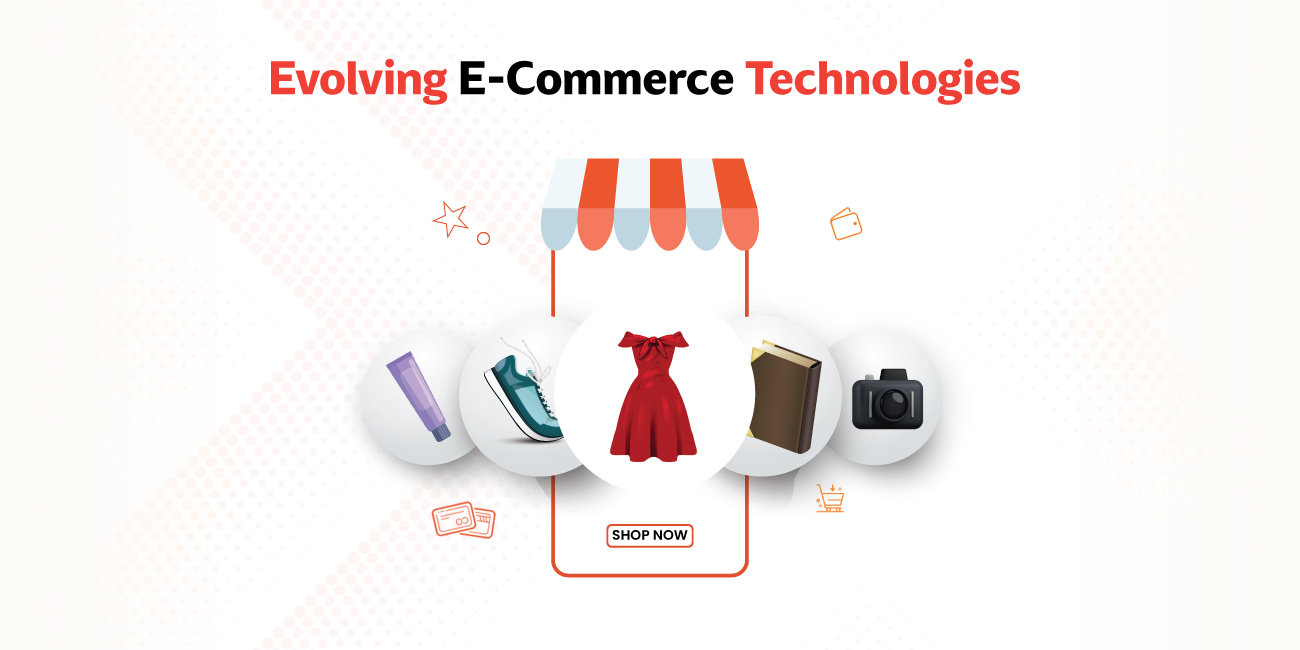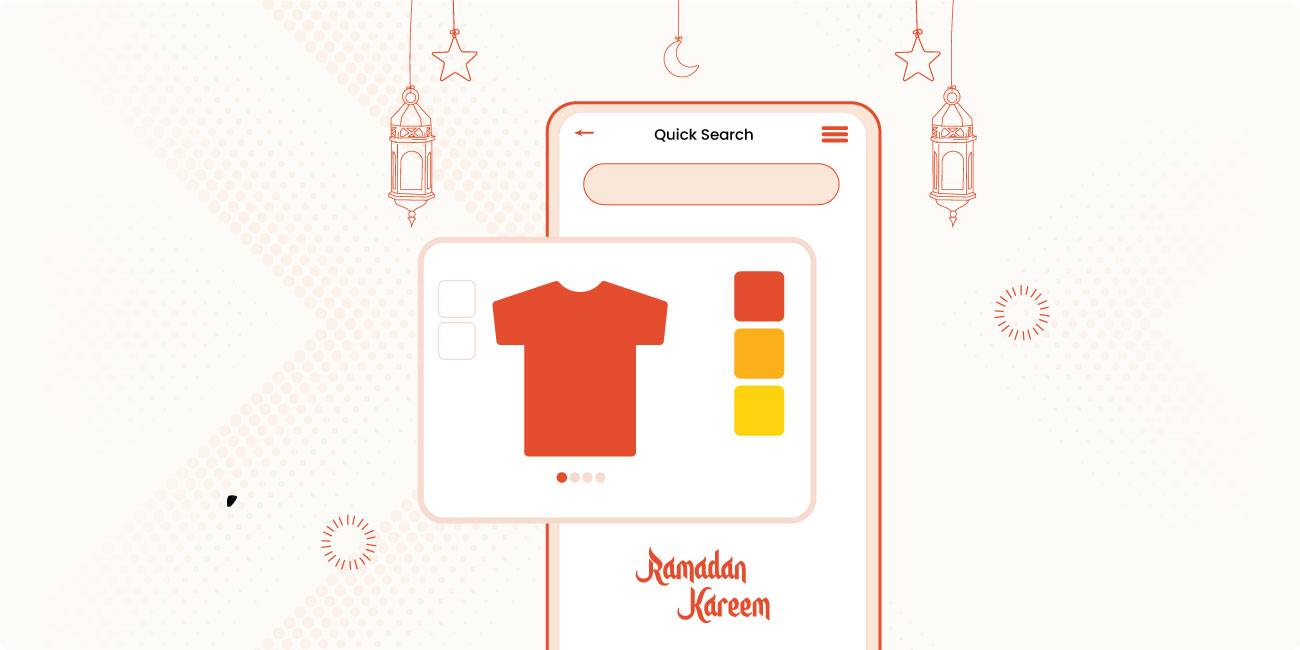
Programmatic advertising is transforming digital marketing by automating ad buying and selling. By 2025, experts predict 90% of digital ads will be purchased programmatically, yet many marketers still struggle with transparency and ROI. This guide will break down everything you need to know, from basic definitions to advanced 2025 trends like AI and cookie-less targeting. Whether you’re a global brand or an SME, you’ll learn how to leverage programmatic ads effectively. Start with our free 2025 trends report to stay ahead.
What Is Programmatic Advertising?
What Is Programmatic Advertising?
What Is Programmatic Advertising?
Programmatic advertising is the AI-driven process of buying and selling digital ad space in milliseconds using automated technology and real-time data. Think of it like stock trading for ads—instead of manual negotiations, algorithms analyze user data and bid on impressions instantly to show the right ad to the right person at the perfect time.
This method replaces traditional ad buying, which relied on phone calls, spreadsheets, and guesswork. Now, demand-side platforms (DSPs) and supply-side platforms (SSPs) connect advertisers and publishers through lightning-fast auctions. Key components include real-time bidding (RTB), audience targeting, and dynamic ad placements across websites, apps, and streaming platforms.
In Short: “Programmatic advertising automates digital ad buying using AI, analyzing user data to bid on impressions in real time. It replaces manual processes with DSPs and SSPs, ensuring ads reach the right audience instantly across websites, apps, and video platforms.”
By 2025, programmatic advertising is expected to dominate ad spending due to its precision and efficiency. Brands can target users based on behavior, location, and even weather, all while optimizing budgets automatically. According to Statista, global programmatic ad spend is projected to reach an estimated 800 billion U.S. dollars by 2028. Furthermore, Statista forecasts that by 2029, 85% of total advertising revenue will be generated through programmatic advertising.
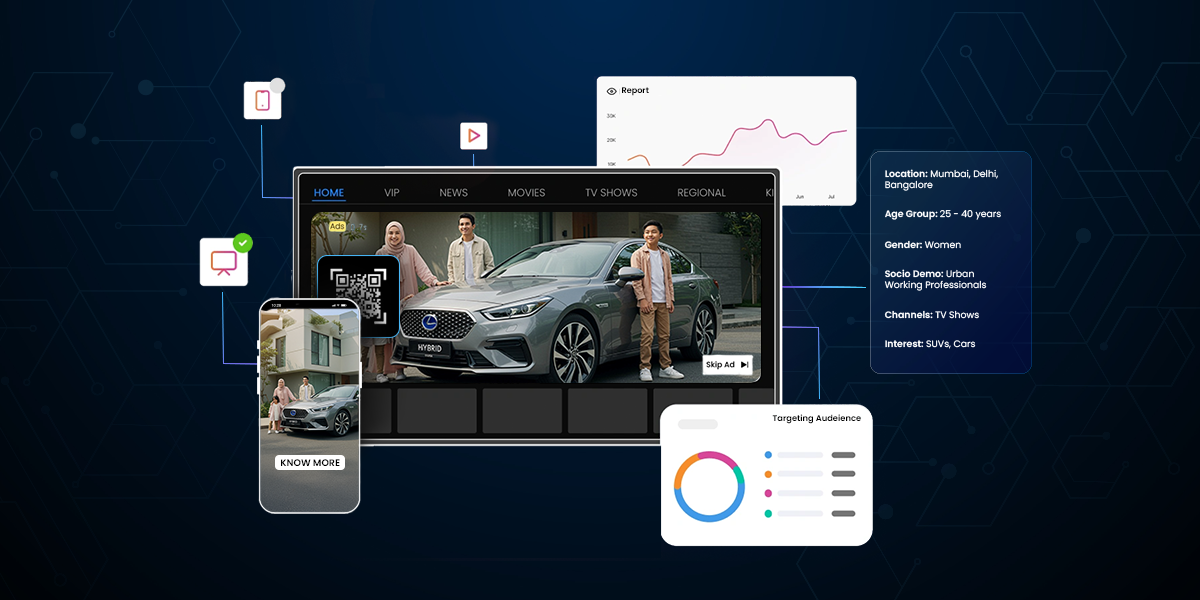
Why Programmatic Advertising Matters
Programmatic advertising has revolutionized digital marketing by replacing slow, manual ad buys with real-time, AI-driven precision. Its importance stems from three core advantages: efficiency, targeting, and scalability.
Unrivaled Efficiency
Gone are the days of RFPs and insertion orders. Programmatic automates the entire ad-buying process, executing thousands of micro-decisions per second. Brands save 60%+ of traditional media-buying overhead while eliminating human errors.
Surgical Audience Targeting
Legacy ads spray messages blindly. Programmatic analyzes 100+ data signals beyond the basic location, age and gender—browsing behavior, purchase intent, even weather—to serve hyper-relevant geo-targeted ads. A sneaker ad appears only to marathon trainers checking race results, not casual readers.
Real-Time Optimization
Campaigns self-adjust mid-flight. If video ads perform better at 9 PM on CTV, budgets automatically shift within minutes. No waiting for weekly reports to course-correct.
Transparent Performance
Every impression is trackable. Marketers see exact viewability rates, fraud filters, and attribution paths, unlike traditional media’s “spray and pray” measurement.
Global Scale, Local Precision
Run worldwide campaigns while targeting neighborhood-level nuances. A coffee chain promotes iced drinks in Miami and hot lattes in Minneapolis simultaneously.
Future-Proof Adaptability
As cookies fade, programmatic pivots seamlessly to contextual AI and first-party data, keeping brands compliant without sacrificing performance.
The result? Campaigns that convert better, waste less, and evolve faster. In 2026, 91% of display ads will be programmatic—not because it’s trendy, but because it simply works.
Why is programmatic advertising important?
Programmatic advertising is important because it automates the buying and selling of digital ads. This makes the process faster, smarter, and more efficient. Instead of negotiating deals manually, ads are bought in real time using software and data.
It helps advertisers reach the right audience at the right time. This is done by targeting users based on their behavior, interests, location, and more. As a result, campaigns become more relevant and effective.
It also saves time. What once took days or weeks to plan can now happen in milliseconds. This speed allows marketers to adjust their campaigns instantly based on performance.
Another key benefit is cost-efficiency. Since ads are bought through auctions, advertisers only pay what the impression is worth. This often reduces waste and improves ROI.
Programmatic advertising gives access to a wide range of platforms and devices. You can run one campaign across websites, apps, smart TVs, and more. This creates a consistent experience for the audience.
It also provides deep insights. Marketers can track performance in real time and optimize for better results. This leads to continuous improvement of campaigns.
How Programmatic Advertising Is Evolving in 2025
Programmatic advertising is undergoing its most significant transformation yet. As we approach 2025, four major technological advancements are revolutionizing how ads are bought, served, and optimized. These innovations are making programmatic advertising more intelligent, privacy-compliant, and effective than ever before.
AI and Machine Learning Revolution
The integration of AI is fundamentally changing programmatic advertising by automating and enhancing key processes:
- Predictive Bidding: Advanced algorithms now analyze historical user behavior, purchase intent signals, and real-time engagement patterns to predict which impressions will drive conversions. By evaluating thousands of data points in milliseconds, these systems automatically adjust bids to maximize ROI—spending more on high-value users while filtering out wasted impressions.
- Dynamic Creative Optimization (DCO): Rather than serving static ads, AI now tailors every element—images, copy, CTAs—based on individual user profiles. A single ad template can generate thousands of variations, testing different combinations in real time to determine which performs best for each segment.
- Automated Budget Allocation: Machine learning continuously monitors campaign performance across channels, shifting budgets hourly to the highest-converting placements. If a particular audience segment responds better on mobile vs. desktop, the system reallocates spend without manual intervention.
The Rise of CTV and Programmatic Audio
Streaming platforms and digital audio are becoming dominant programmatic channels:
- Connected TV (CTV) Advancements: Ads on Hulu, Roku, and smart TVs now use household-level targeting based on viewing history and demographics. Advanced attribution tracks when CTV ads drive website visits or store purchases.
- Programmatic Podcast Advertising: Dynamic ad insertion technology allows host-read sponsorships to be added post-production and swapped based on listener demographics. Ads can be geo-targeted or updated for timeliness.
- TikTok’s Sonic Branding: Audio recognition technology matches brand jingles with relevant user-generated content. Even without visuals, sonic logos trigger brand recall when played over TikTok clips.
Blockchain for Transparency and Fraud Prevention
New verification technologies are cleaning up the programmatic ecosystem:
- Smart Contract Verification: Self-executing blockchain contracts validate that ads were served to real humans in brand-safe environments before releasing payments.
- Supply-Path Optimization: Full auction path tracking exposes hidden fees and redundant tech charges that inflate CPMs. Buyers can identify the most efficient routes to premium inventory.
- Collaborative Fraud Blocklists: Industry-wide databases share known fraudulent domains and non-human traffic patterns, allowing platforms to automatically filter out bad actors.
These innovations make 2025 programmatic advertising more efficient, privacy-conscious, and accountable than ever before, ushering in a new golden age of digital marketing.
Types of Programmatic Advertising
Programmatic advertising isn’t a one-size-fits-all solution. Different buying methods exist to match specific campaign goals—whether you want maximum scale, premium placements, or guaranteed results. Below, we break down the 6 main types of programmatic advertising, their pros and cons, and when to use each.
1. Real-Time Bidding (RTB) – The Open Auction
Best for: Advertisers wanting large-scale reach at competitive prices.
How it Works: When a user visits a website, the ad impression is auctioned to thousands of advertisers in milliseconds. The highest bidder wins and serves their ad—all before the page loads.
Pros:
- Huge inventory pool (websites, apps, videos)
- Cost-efficient (pay only for impressions you win)
- Real-time optimization
Cons:
- Less control over ad placements
- Risk of low-quality traffic
2. Private Marketplace (PMP) – VIP Auctions
Best for: Brands wanting premium, curated inventory with some control.
How it Works: Publishers invite select advertisers to bid on exclusive inventory (e.g., high-traffic news sites).
Prices are higher, but quality and brand safety improve.
Pros:
- Access to premium sites (e.g., Forbes, ESPN)
- More transparency than open RTB
- Better audience targeting
Cons:
- Limited inventory (only invited buyers)
- Higher CPMs than open auctions
3. Programmatic Guaranteed – Fixed Deals
Best for: Guaranteed ad placements with predictable costs.
How it Works: Advertisers and publishers negotiate fixed prices and impressions upfront (like traditional
ads, but automated). No bidding—just reserved, guaranteed placements.
Pros:
- 100% guaranteed impressions
- Fixed pricing (no auction fluctuations)
- High-quality, brand-safe placements
Cons:
- Less flexibility (fixed budgets/dates)
- Requires direct publisher relationships
4. Preferred Deals – First Dibs on Premium Ads
Best for: Advertisers who want priority access without full commitments.
How it Works: Publishers offer inventory to preferred buyers before it goes to open auctions. Advertisers can accept or reject at a fixed CPM.
Pros:
- Early access to premium impressions
- No minimum spend requirements
- More control than RTB
Cons:
- Still competitive (not guaranteed)
- Limited scale
5. Header Bidding – Maximizing Publisher Revenue
Best for: Publishers (but advertisers benefit from more inventory).
How it Works: Publishers send ad requests to multiple exchanges at once (instead of one at a time), creating competition that drives up bid prices.
Pros (for advertisers):
- More high-quality inventory available
- Fairer auction dynamics
Cons:
- Slower page load times (if not optimized)
6. Programmatic Direct – Automated Reserved Buys
Best for: Large brands running scheduled campaigns (e.g., product launches).
How it Works: Ads are booked directly with publishers (like guaranteed deals), but the entire process—negotiation, insertion orders, delivery—is automated.
Pros:
- Combines automation with direct-buy security
- Premium placements without manual hassle
Cons:
- Less flexibility for last-minute changes
Comparison Table: Which Type Should You Use?
Key Takeaways
- Use RTB for cost-efficient, large-scale campaigns.
- Choose PMPs for premium, brand-safe inventory.
- Guaranteed deals work best for must-have placements.
- Header bidding benefits publishers but improves advertiser access.
Each method has trade-offs between cost, control, and convenience. The right choice depends on your budget, audience, and campaign goals.
How Programmatic Advertising Works: A Step-by-Step Breakdown
To understand how programmatic advertising delivers ads in milliseconds, let’s follow the journey of a single ad impression—from the moment a user clicks on a website to when the ad appears on their screen.
Step 1: User Visits a Website
When someone opens a webpage, the publisher’s ad server detects available ad space (like a banner or video slot) and sends a bid request to the Supply-Side Platform (SSP).
- Key Data Sent:
- Website URL & content category (e.g., “sports news”)
- User’s device, location, and anonymized browsing history (if consented)
- Ad slot size (e.g., 300×250 pixels)
Step 2: Auction Starts (Real-Time Bidding)
The SSP forwards the bid request to multiple ad exchanges and Demand-Side Platforms (DSPs). Advertisers pre-set rules in their DSPs, like:
- “Bid $2 CPM for sports fans in London”
- “Avoid adult or controversial content.”
How Bidding Happens:
- DSPs analyze the user’s profile against campaign targets.
- Algorithms predict the user’s likelihood to convert (e.g., click or buy).
- Eligible advertisers submit bids (takes <100ms).
Step 3: The Winner is Chosen
The highest bidder wins, but pays one cent more than the second-highest bid (to keep auctions fair). The winning ad is:
- Checked for malware/brand safety.
- Formatted to fit the ad slot.
- Sent back to the publisher’s page.
Step 4: Ad Appears to the User
The entire process—from bid request to ad display—happens before the webpage finishes loading. The user sees a relevant
ad without noticing the auction.
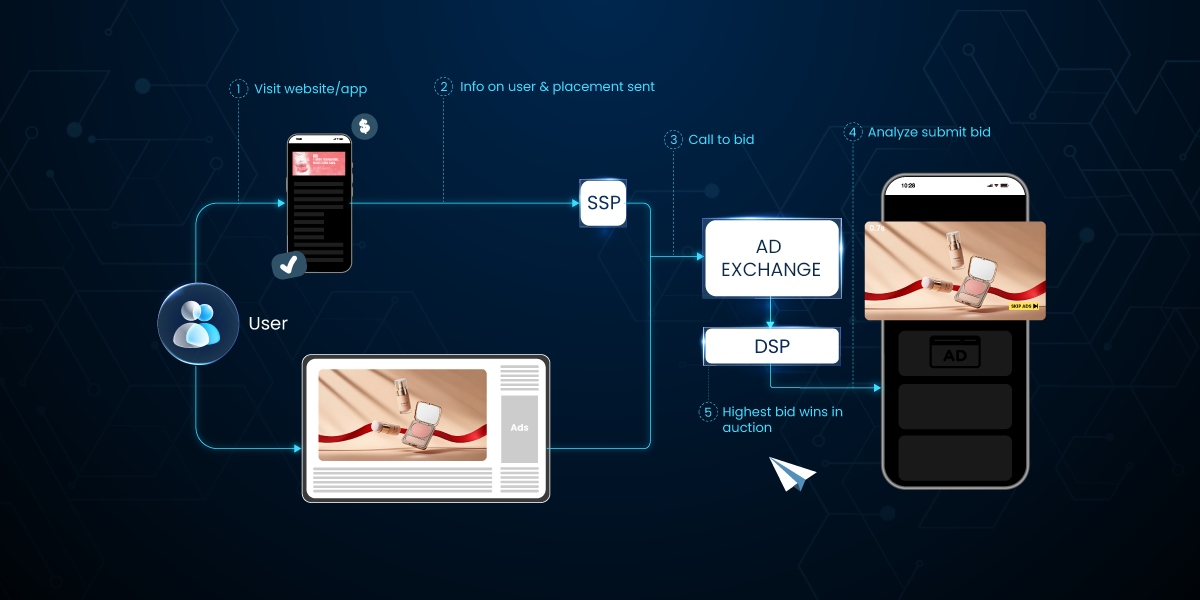
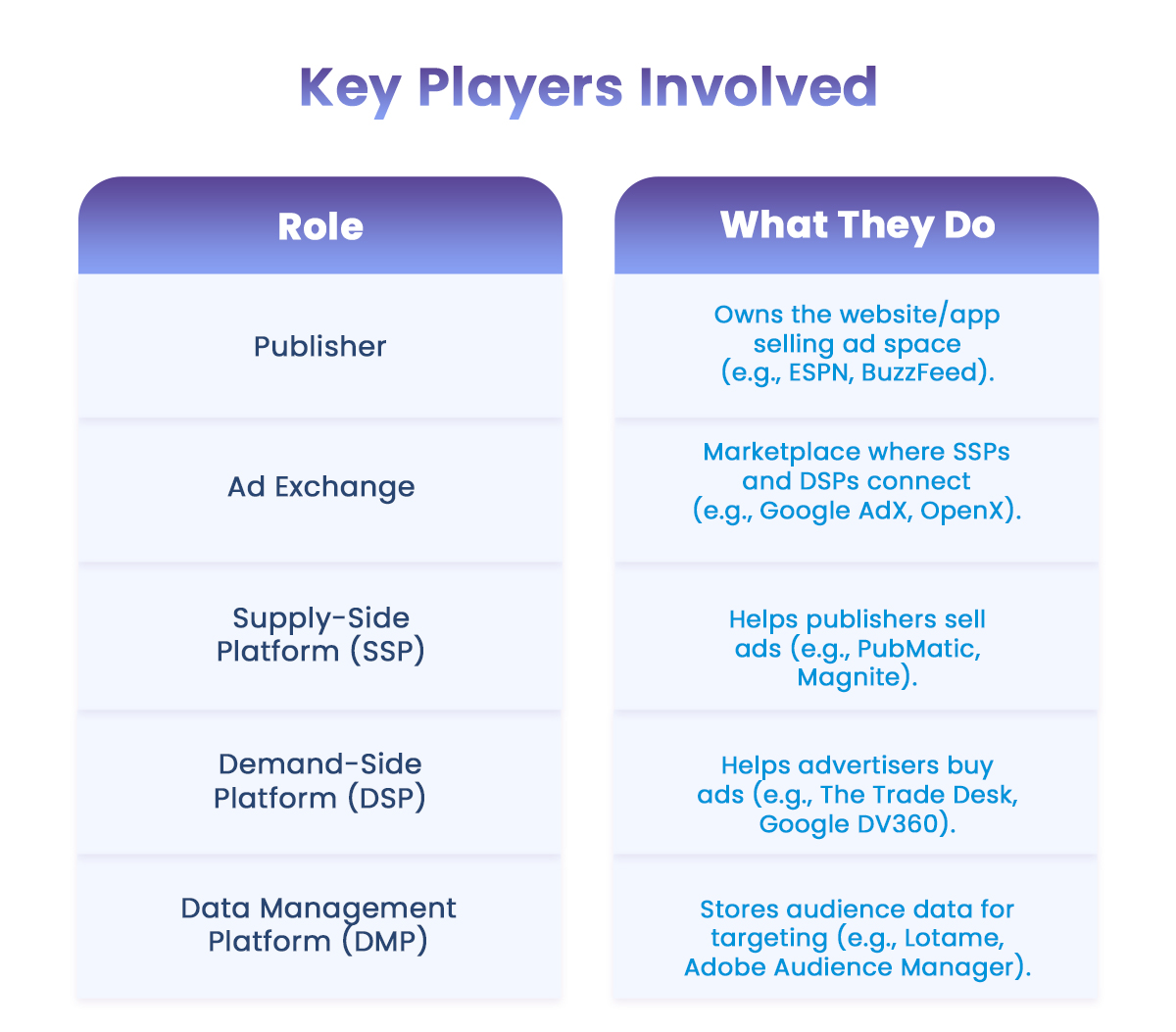
Types of Programmatic Platforms
Programmatic advertising thrives on specialized platforms that automate media buying and selling. Each platform serves a distinct role—connecting advertisers, publishers, and data providers in a lightning-fast digital marketplace. Below, we break down the five core platform types, their key capabilities, and leading examples.
1. Demand-Side Platforms (DSPs)
What They Do: DSPs enable advertisers to buy ad inventory across multiple publishers via real-time auctions. They use AI to bid on impressions that match campaign targets (audience, budget, KPIs).
Key Capabilities:
- Cross-channel buying (web, mobile, CTV, audio)
- Real-time bidding (RTB) optimization
- Advanced audience targeting (1st/3rd-party data)
- Fraud detection & brand safety filters
Top 5 DSP Examples:
- The Trade Desk (Largest independent DSP)
- Google DV360 (Deep integration with YouTube/Google Ads)
- Xapads DSP (Specializes in emerging markets & mobile apps)
- Amazon DSP (Access to Amazon shopper data)
- MediaMath (Pioneer in algorithmic buying)
2. Supply-Side Platforms (SSPs)
What They Do: SSPs help publishers sell ad inventory by connecting them to DSPs, ad exchanges, and networks. They maximize revenue by auctioning impressions to the highest bidder.
Key Capabilities:
- Header bidding & waterfall optimization
- Floor price management
- Direct deals (PMPs, programmatic guaranteed)
- Ad quality & blocking controls
Top 5 SSP Examples:
- Google Ad Manager (Dominates publisher ad servers)
- PubMatic (Strong in video & CTV)
- Magnite (Merged Rubicon Project + Telaria)
- Xapads SSP (Focus on APAC & mobile publishers)
- OpenX (Independent exchange with transparency focus)
3. Ad Exchanges
What They Do: Ad exchanges act as digital marketplaces where DSPs and SSPs connect to trade inventory. They standardize auction mechanics and pricing.
Key Capabilities:
- Real-time auction infrastructure
- Inventory aggregation (thousands of publishers)
- Price floor controls
- Fraud monitoring
Top 5 Ad Exchange Examples:
- Google AdX (Largest global exchange)
- Xandr (Microsoft) (Premium inventory focus)
- Index Exchange (Header bidding leader)
- Smaato (Mobile-first exchange)
- Xapads Exchange (APAC & high-growth markets)
4. Data Management Platforms (DMPs)
What They Do: DMPs collect, analyze, and segment audience data to fuel targeting across DSPs. They’re critical for cookie-less strategies.
Key Capabilities:
- Audience segmentation (e.g., “luxury car shoppers”)
- Cross-device ID resolution
- CRM data integration
- Privacy compliance tools
Top 5 DMP Examples:
- Lotame (Independent DMP)
- Adobe Audience Manager (Part of Adobe Experience Cloud)
- Salesforce DMP (B2B & CRM integration)
- Neustar (Identity resolution specialist)
- Xapads DMP (Emerging market audience data)
5. Hybrid Platforms
What They Do: Hybrid platforms combine DSP + SSP functionalities, offering end-to-end control for advertisers and publishers.
Key Capabilities:
- Unified buying/selling interfaces
- Reduced tech fees (no middlemen)
- Direct deal facilitation
- Full-funnel reporting
Top 5 Hybrid Examples:
- Xapads (DSP+SSP for mobile & APAC markets)
- SmartyAds (Self-serve programmatic suite)
- Bidswitch (Kargo’s convergence platform)
- Epom Ad Server (SSP with DSP features)
- Adform (Unified analytics + buying)
Why Platform Choice Matters
- Advertisers: Prioritize DSPs with inventory access matching your audience (e.g., Xapads for mobile gamers).
- Publishers: SSPs like PubMatic optimize revenue for video-heavy sites.
- Data-Driven Brands: DMPs like Lotame future-proof targeting amid cookie deprecation.
Pro Tip: Xapads stands out for brands targeting India, Southeast Asia, and hyper-casual apps, offering localized support and cost-efficient scaling.
Programmatic Advertising for SMEs & Enterprises
Programmatic advertising isn’t just for Fortune 500 brands. With the right approach, SMEs can compete with enterprise budgets, while large corporations unlock granular control. Here’s how to leverage platforms like Xapads at every business tier.
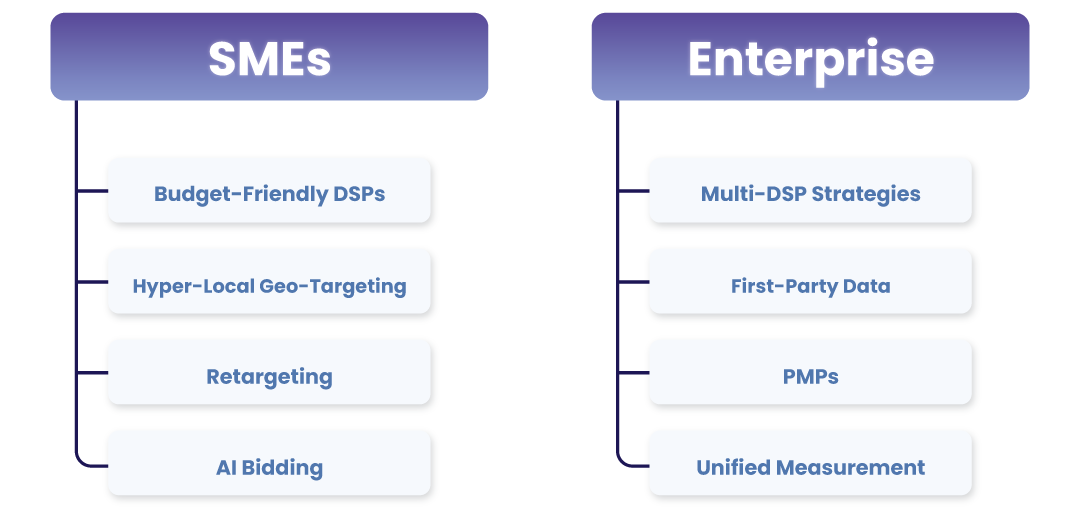
For SMEs: Cost-Efficient Growth Hacks
- Start with Budget-Friendly DSPs
- Platforms like Xapads DSP offer low minimum spends and self-serve tools.
- Focus on performance channels: mobile apps, social feeds, and high-impression
websites.
- Hyper-Local Geo-Targeting
- A bakery can target users within 3 miles during breakfast hours.
- Use Xapads’ regional filters to exclude non-relevant traffic.
- Retargeting on a Shoestring
- Pixel visitors who abandoned carts, then serve dynamic ads with discounts.
- Xapads’ SME plans include free retargeting templates.
- Leverage AI Bidding
- Automated rules like “Cap CPC at $0.30” prevent overspending.
For Enterprises: Precision at Scale
- Multi-DSP Strategies
- Combine Xapads (emerging markets) with Google DV360 (premium inventory).
- Allocate budgets based on regional performance.
- First-Party Data Activation
- Sync CRM lists to Xapads’ DMP for lookalike audiences.
- Target high-LTV segments across CTV, DOOH, and in-app.
- Private Marketplaces (PMPs)
- Negotiate exclusive deals with premium publishers via Xapads’ SSP.
- Guarantee brand-safe placements in niche verticals (e.g., finance, healthcare).
- Unified Measurement
- Track offline conversions (store visits, calls) tied to programmatic ads.
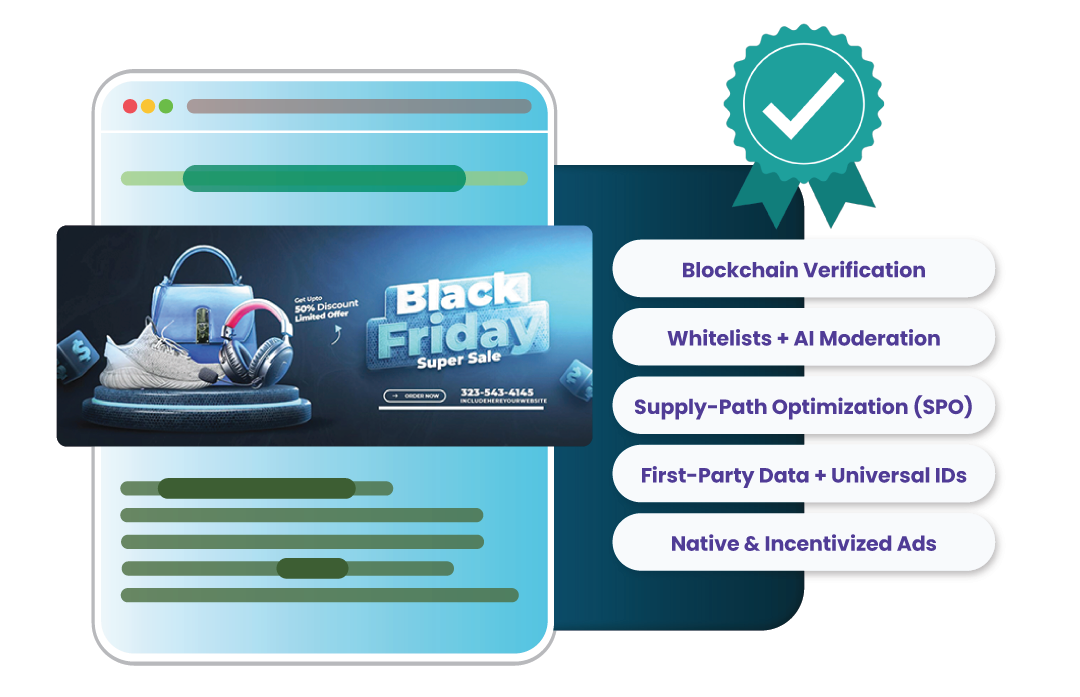
Common Programmatic Advertising Challenges & Solutions
Programmatic advertising delivers precision and scale, but it’s not without hurdles. From ad fraud to brand safety risks, marketers must navigate these challenges to maximize ROI. Below, we break down the top 5 programmatic pain points and proven solutions—including emerging tech like blockchain and AI moderation.
1. Ad Fraud: The $68 Billion Problem
Challenge:
Bots and fake sites drain budgets by generating fake impressions/clicks. Sophisticated fraud includes:
- Domain spoofing (masking low-quality sites as premium)
- Pixel stuffing (loading invisible ads)
- Click farms (manual fraud in high-volume regions)
Solution: Blockchain Verification
- Smart contracts validate impressions before payment (e.g., Kochava).
- Ads.txt files prevent counterfeit inventory.
2. Brand Safety: Avoiding Risky Placements
Challenge:
Ads appear alongside hate speech, fake news, or pirated content—harming reputation.
Solution: Whitelists + AI Moderation
- Whitelists: Curate approved sites (e.g., only ESPN, Bloomberg).
- AI tools (like DoubleVerify) scan page content pre-bid.
Tip: Exclude sensitive keywords (e.g., “war,” “politics”).
3. Lack of Transparency: Hidden Fees & Data Silos
Challenge:
Unseen “ad tech tax” (middlemen fees) eats 40-60% of budgets (ANA).
Solution: Supply-Path Optimization (SPO)
- Audit auction paths to eliminate redundant SSPs.
- Direct deals with publishers via Xapads’ PMPs.
- Demand log-level data from DSPs.
4. Cookie Deprecation: Targeting Disruption
Challenge:
Third-party cookie loss cripples retargeting and audience segmentation.
Solution: First-Party Data + Universal IDs
- Build email lists (e.g., loyalty programs).
- Adopt UID2 cookieless targeting (contextual AI).
Stat: 78% of marketers now prioritize first-party data (eMarketer).
5. Ad Blocking: 30% of Users Opt Out
Challenge:
Ad blockers prevent ads from reaching valuable audiences.
Solution: Native & Incentivized Ads
- In-feed native ads blend with content (60% higher engagement).
- Rewarded ads (e.g., “Watch an ad for bonus game coins”).
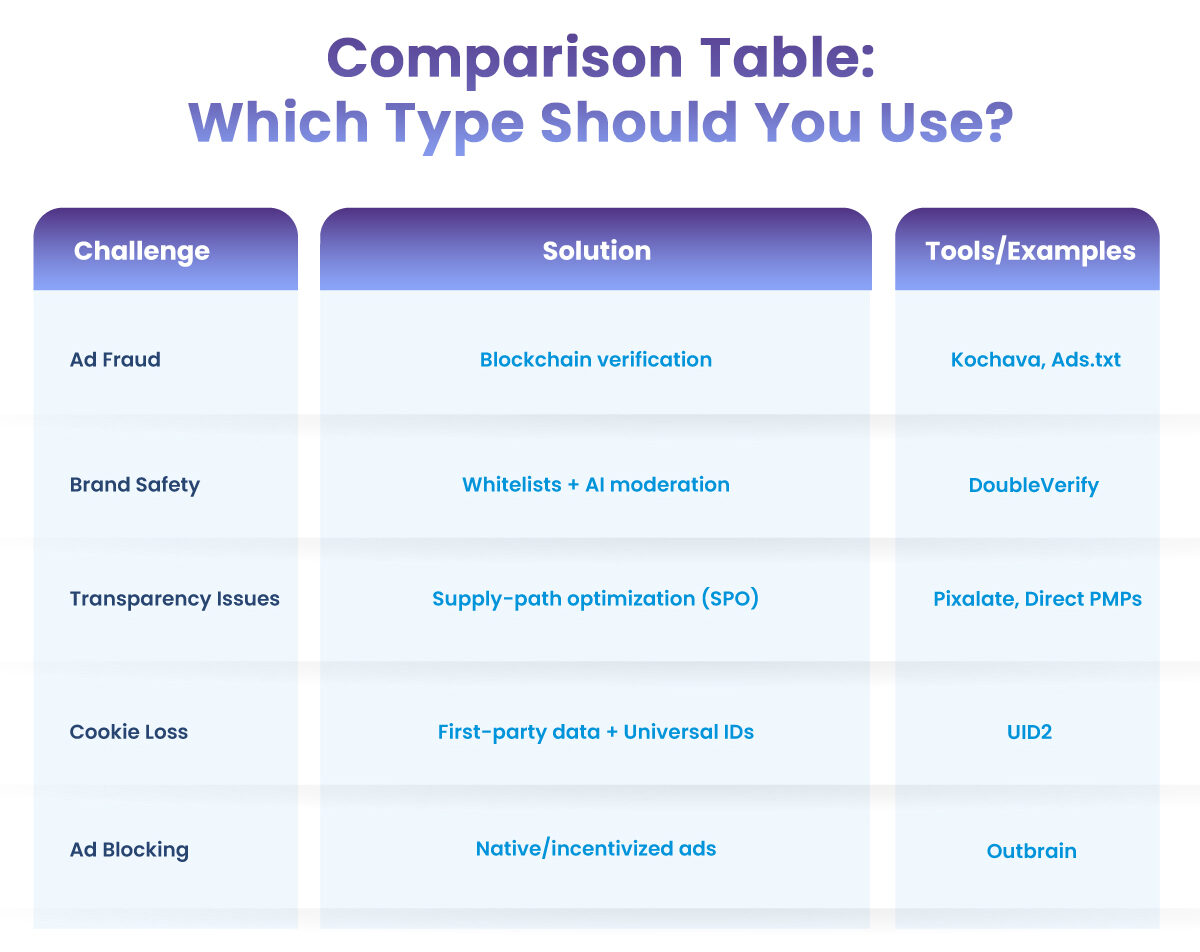
The Future of Programmatic Advertising (2025–2030): 5 Transformative Shifts
Programmatic advertising is poised for its most radical evolution yet. Between 2025 and 2030, expect these game-changing developments to redefine digital marketing. Voice and search ads will merge seamlessly, with smart assistants like Alexa serving hyper-contextual promotions mid-conversation (“Since you asked about yoga mats, here’s a 20% offer from Nike”). The metaverse will unlock an entirely new inventory—imagine bidding for virtual billboards in Fortnite concerts or avatar clothing ads in Decentraland, all traded programmatically.
AI will dominate media planning, with self-optimizing campaigns that adjust creative, timing, and bids in real time without human input. Google and Meta are already testing fully autonomous ad accounts that outperform manual strategies by 30%. Privacy-safe targeting will thrive through zero-party data exchanges, where users voluntarily share preferences via interactive ads (e.g., “Get a free recipe ebook by telling us your diet goals”).
CTV and retail media networks will converge, enabling one-click purchases from streaming ads. Walmart Connect and Amazon DSP will leverage shopper data to serve programmatic ads with instant checkout on smart TVs. Meanwhile, blockchain-based ad ledgers will become standard, eliminating fraud by publicly verifying every impression. Expect 80% of ads to use dynamic AI-generated creatives by 2030—personalized videos crafted in milliseconds based on your browsing mood.
The next five years will blur the lines between ads and experiences. Programmatic won’t just follow audiences—it will anticipate intent and embed into digital life invisibly. Brands adopting these early will dominate; laggards will struggle to catch up.
- 55% of ads will be AI-generated by 2027 (Gartner)
- Metaverse ad spend to hit $20B by 2026 (Juniper)
- Voice ad revenue will grow 400% by 2030 (OC&C)
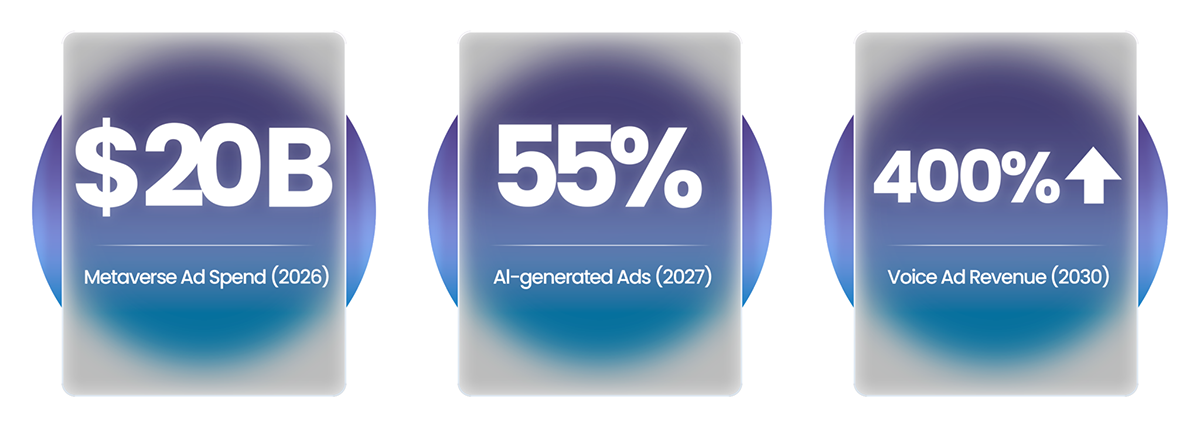
Case Study
Myco Dubai | Watch, Earn, Own
Campaign Objective
MyCo, an innovative OTT platform, wanted to:
- Boost awareness about its unique “Watch
It, Earn It, Own It” model. - Increase app downloads by targeting
quality users (crypto and OTT enthusiasts). - Enhance engagement and retention on
their platform.
Xapads used AI-driven strategies to:
- Target crypto-savvy users (ages 25–45)
in the UAE who love OTT platforms. - Run YouTube and in-app ads (pre-roll,
mid-roll) to catch attention during video streaming. - Use Pulse AI to analyze viewer
interests and sentiments (e.g., excitement for crypto trends).
Campaign Outcome
The results were blockbuster-level:
- 2M+ impressions (ads seen).
- 1.5M+ reach (unique users).
- 8.8K+ clicks to download the
app. - 1.7M+ video views (high
engagement).
This campaign crushed it, winning 6 awards for innovation, targeting, and results!
Conclusion
Programmatic advertising is no longer optional—it’s the backbone of modern digital marketing. From AI-driven optimizations and cookie-less targeting to blockchain transparency and immersive metaverse ads, the future belongs to brands that embrace automation, precision, and adaptability.
For SMEs, programmatic offers cost-efficient scaling through geo-targeting and retargeting hacks. Enterprises leverage multi-DSP strategies and private marketplaces for premium reach. Meanwhile, emerging solutions like Xapads bridge gaps in high-growth markets with hybrid DSP+SSP capabilities.
Challenges like ad fraud and brand safety persist, but innovations in AI moderation, first-party data, and supply-path optimization are turning risks into opportunities.
As voice search, CTV, and the metaverse reshape advertising, one truth remains: programmatic is the fastest, smartest way to connect with audiences—anywhere, anytime. Start future-proofing your strategy today.
Thanks for reading! Curious about how Programmatic Advertising can grow your business?
Let’s talk — book a free consultation today and discover what’s possible.

